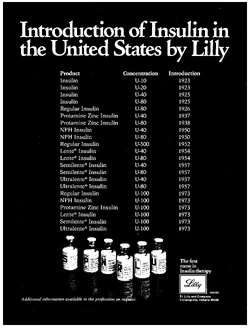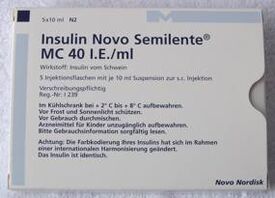
Iletin I Semilente, a beef/pork semilente insulin was part of Lilly's insulin line in 1992.

From left-insulins Semilente ("S"), Protamine Zinc ("P"), NPH/isophane ("N"), Regular/neutral/normal ("R"), Lente ("L"), and Ultralente ("U").
The lente types of Semilente, Lente and Ultralente are also called zinc suspension insulins.
Semilente insulin is defined as a short-acting insulin containing zinc microcrystals in an acetate buffer. [1][2] This insulin is known by two other names: Prompt Zinc and Prompt Lente; this to distinguish it from the Lente and Ultralente insulins which are also part of the zinc suspension group, but whose onsets are slower and whose durations are longer. British Pharmacoepia (BP) and United States Pharmacoepia (USP)'s definitions of semilente insulin: [3]
When reading a description of Lente insulin, the word amorphous [4] is often used; the description is often used interchangably with the semilente term, in speaking of the 30% fraction of Lente that is semilente insulin.
While both R/neutral and semilente insulins are considered fast-acting, they differ in a few ways. There's no suspension [5] or buffer[6] in R/neutral; it's totally dissolved and soluble, meaning it can safely be used intravenously.
The very small insulin particles in semilente insulin are suspended by zinc. [7] Semilente is cloudy, has an acetate buffer and cannot be used intravenously.[8]
R/Neutral insulin cannot be reliably mixed with Lente or Ultralente insulins. [9][10] Semilente can; the ratio of 3 parts semilente insulin to 7 parts ultralente insulin produces Lente insulin. [11]
Technical details[]
Semilente's time activity profile is very much like that of R/neutral. It begins [12]working within 45 minutes, peaks in 2-4 hours and has a 4-6 hour duration. In dogs, both r-DNA/GE/GM and Bovine species have an onset of 10-30 minutes, peak of 1-5 hours, and duration of 4-10 hours. [13]
Unlike R/neutral, it is "cloudy", not clear, and is not soluble, therefore unable to be used intervenously.
This type of insulin was once as available as R/neutral; many people preferred it over R/neutral for bolus insulin. It has now almost disappeared entirely from the market. We know semilente best as one of the two lente-types which comprise Lente insulin; Ultralente is the other.
Semilente [14] is unique among the fast and short-acting insulins because changes in temperature to the body do not affect its absorption rate, as is the case with the soluble insulins. A study placed people in saunas for two 25 minute periods; the intense heat had no effect on the absorption rate. This type of heat would have caused the soluble insulins to be absorbed at a faster than normal rate, bringing with it the possibility of hypoglycemia.
What Semilente Is Not[]
No Lente-type insulin regardless of species can contain any NPH/isophane insulin. [15] or any R/Neutral insulin [16][17]
Both are chemically impossible: the phenol preservative present in NPH/isophane alters the action of Lente-type insulins, creating a mixture with an approximate action of R/Neutral. [18][19]
The zinc suspension of Lente-type insulin binds R/Neutral, causing the short-acting insulin to slow, losing its short-acting effect. [20][21]
Before the invention of VetPen, Lente-type insulins could not be dispensed in pen or cartridge form because the glass ball formerly used to mix the insulin in these devices shattered the Lente crystals.[22]
Combining Lente Family Insulins[]
|
None of the Lente family of insulins (semilente, Lente, Ultralente) can be combined with [23] NPH/isophane insulins. The phenol preservatives present in NPH-type insulins alters the Lente-types to the point where they become a close approximation of R/neutral, with regard to action. [24][25] Keeping the phenol preservatives in mind, all protamine-suspended insulin mixes would be "off limits" regarding same syringe mixing with any Lente-type insulins. [26] | ||
Insulin manufacturers [27] indicate that R/neutral and semilente, Lente, ultralente insulins are able to be combined in the same syringe, but only just before injection. In pre-filled syringes, the zinc suspension of the Lente-type insulins binds the R/neutral, causing it to lose its short-acting effect. Various studies have documented this, and some doctors advise against using R/neutral in the same syringe with the Lente family of insulins. [28][29][30][31]
Specifications of semilente[]

Novo Nordisk Semilente MC 40- Porcine (Pork) Insulin-German Packaging. This is semilente pork insulin (Insulin vom Schwein) in U40 strength. Novo has discontinued this insulin. [32] and Polfa-Tarchomin (Poland) recently began producing a similar insulin, Insulinum semilente ChO, in U80 strength [33]
Insulin Zinc Suspension BP (Amorphous) [34]
Sterile buffered suspension of mammalian insulin in the form of a complex obtained by addition of zinc chloride. Prepared from crystalline insulin containing not less than 23 u almost colourless suspension in which the particles have no uniform shape and rarely exceed 2 m in dimension; pH 6.9 - 7.5. Iso-osmotic with blood. Containing suitable bactericide, the preparation contains 40 and 80 units/ml.
(Note: At present, porcine semilente insulin is available only through Polfa Tarchomin, Poland. Novo Nordisk discontinued the product shown. It has been many years since any species of semilente has been available elsewhere, hence the lack of a UK U100 definition.)
U.S.P. describes a sterile suspension of insulin U.S.P. in buffered water for injection is modified by addition of zinc chloride so that the solid phase of suspension is amorphous. Contains 40, 80 or 100 units/ml. Also contain sodium acetate 0.15 - 0.17%, sodium chloride 0.65 - 0.75%, methyl hydroxy benzoate 0.09 - 0.11% and for each 100 units of insulin, 120 - 250 g of zinc. pH 7.2-7.5
|
Semilente Insulins | |
|---|---|

|
Short acting Non-soluble |
| Insulinum semilente CHO | |
| Novo Semilente MC (No longer produced.) | |
| Semitard (No longer produced.) | |
| Iletin I Semilente (No longer produced.) | |
An old Novo Nordisk trade name for their semilente is Semitard.
References[]
- ↑ DeRuiter, Jack. Insulin preparations. Auburn University.
- ↑ Definition of Semilente Insulin. Merck Manual.
- ↑ British Pharmacoepia /United States Pharmacopeia: Definitions of Semilente Insulin. InChem.
- ↑ Definition of Amorphous. Dorlands Medical Dictionary.
- ↑ Humulin R. Eli Lilly.
- ↑ DeRuiter, Jack. Insulin Preparations-Regular Insulin. Auburn University.
- ↑ DeRuiter, Jack. Insulin Preparations-Lente. Auburn University.
- ↑ Maddison, Jill E.,Page, Stephen W.,Church, David B. (2008). Small Animal Clinical Pharmacology. Saunders Ltd..
- ↑ Deckert, T. (1980). Intermediate-Acting Insulin Preparations: NPH (Isophane) & Lente. Diabetes Care.
Note--in 1980, there was only beef Lente-type insulin--no pork or r-DNA/GE/GMLente insulins - ↑ Resource Guide. American Diabetes Association (2005).
- ↑ DeRuiter, Jack. Insulin Preparations-Lente Insulin. Auburn University.
- ↑ Semilente Insulin. Wholehealthmd.com.
- ↑ Fleeman, Linda, Rand, Jacqueline (2000). Long-Term Management of the Diabetic Dog-page 2. Waltham.
- ↑ Koivisto VA. (1983). Influence of Heat on Insulin Absorption:Different Effects on Amorphous (Semilente) & Soluble Insulins.
- ↑ Combining Lente-type Insulins with Phenol-Preserved Insulins. National Federation for the Blind.
- ↑ Lente Zinc Suspension Causes Loss Of R/Neutral Short-Acting Effect. Endotext.org.
- ↑ Huffman DM, Garber AJ. (1991). Availability of Soluble (R/Neutral) Insulin in Mixed Preparations With Crystalline (Lente) & Ultralente GE Insulin. Clinical Therapeutics.
- ↑ Lente-Type Insulins & NPH/Isophane Insulins-A Bad Combination. National Federation for the Blind.
- ↑ Havlik I, Galasko G, Alberts E, Furman KI, Seftel HC. (1988). Solubility Changes on Mixing Short- and Long-acting Insulin Preparations. South African Medical Journal.
- ↑ Deckert, T. (1980). Intermediate-Acting Insulin Preparations: NPH (Isophane) & Lente. Diabetes Care.
Note--in 1980, there were no r-DNA/GE/GM insulins - ↑ Resource Guide. American Diabetes Association (2005).
- ↑ Hanas, Ragnar (1999). Insulin-Dependent Diabetes-Page 10. ChildrenWithDiabetes.
- ↑ Phenol Preservatives & Lente-type Insulins--A Bad Combination. National Federation for the Blind.
- ↑ Lente-Type Insulins & NPH/Isophane Insulins-A Bad Combination. National Federation for the Blind.
- ↑ Insulin Therapy-Mixing Precautions. RxEd.org.
- ↑ Insulin Therapy-Mixing Precautions. RxEd.org.
- ↑ Insulin Producers vs Doctors Re:Combining R/Neutral & Lente-type Insulins. Endotext.org.
- ↑ Huffman DM, Garber AJ.. Availability of Soluble (R/Neutral) Insulin in Mixed Preparations of Crystalline (Lente) & Ultralente GE Insulins. Clinical Therapeutics.
- ↑ Bilo HJ, Heine RJ, Sikkenk AC, van der Meer J, van der Veen EA. (1987). Absorption Kinetics & Action Profiles-Single Subcutaneous Administration of Human Soluble (R/Neutral) & Lente Insulin. Diabetes Care.
- ↑ Heine RJ, Sikkenk AC, Eizenga WH, van der Veen EA. (1983). Delayed Onset of Action of Soluble (R/Neutral) Insulin After Premixing With Lente Insulin Diabetes. Research & Clinical Practice.
- ↑ Insulin Therapy-Mixing Precautions. RxEd.org.
- ↑ Novo Nordisk Withdraws Animal Insulins Worldwide. Forum Insulin Schweiz.
- ↑ Insulinum semilente ChO. Diabetes News de.
- ↑ Physical Properties--Insulin. InChem.
More Information[]
- Lente Insulins-Injectable Suspensions West Virginia University College of Pharmacy-2009